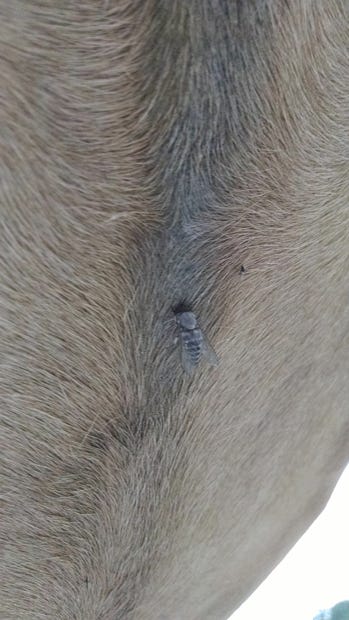
There are many external parasites that affect horses. Some are just annoying, but some transmit deadly diseases.
The world’s deadliest creature is also a menace to horses. These creatures transmit Eastern Equine Encephalomyelitis, Western Equine Encephalomyelitis, Venezuelan Equine Encephalomyelitis and West Nile viruses. This deadly creature is the mosquito.
Our best defense against these deadly diseases is vaccination. The most effective mosquito control measure is reducing breeding sites (standing water). Clean water buckets and troughs regularly since mosquitoes will lay eggs in these water sources. Mosquito control sprays also help to decrease populations.
There are many biting flies that can also transmit diseases such as anthrax, equine infectious anemia, and anaplasmosis. Horse, deer and stable flies are vicious biters and strong flyers. Like mosquitoes, horse and deer fly females are the biters, while both stable fly sexes bite. The use of repellents can be effective for decreasing bites on horses but should be applied daily.
Another annoying pest is the biting midge also called the no-see-um. These pests cause horses to lose their hair where they are bit. Often this is on the neck, head, tail, and belly. There are no effective control measures for these pests. No-see-ums are most active dusk and dawn and prefer to be outdoors in calm winds. An effective strategy for horse owners is to stable horses before dusk until after dawn.
We have non-biting flies that are problems as well. These include house flies, eye gnats and blow flies. House flies can transmit diseases and internal parasites.
Control includes removing manure from the stable area and applying larvicide to the manure. Also, space sprays are effective but must be reapplied frequently.
Eye gnats are annoying and cannot be effectively controlled. Blow flies are problematic for open wounds and control focuses on proper wound care and disposal of soiled wound dressing.
Another fly that buzzes around your horse is the bot fly. This fly is an external and internal parasite. The adult bot fly lays its eggs on the hairs of the horse. The egg hatches and the larvae enters the horse when the horse licks or chews the area where the eggs are attached to hairs.
The larvae burrows into the lining of the mouth and lives there for 3-4 weeks. It then migrates to the stomach and intestine, where it remains until the next summer.
It then is passed in the manure and burrows into the soil. In one to two months, the adult fly emerges and begins immediately laying eggs.
Control of this pest involves breaking the life cycle. Use a warm water wash (110-120 degrees Fahrenheit) with an insecticide to remove bot eggs. The warm water signals the bot egg to hatch and the larvae is killed when it contacts the insecticide.
Only use insecticides that are labeled for external treatment of horses. Treatments should be applied weekly during August and September. Also, dewormers containing ivermectin and moxidectin are effective against internal bot larvae.
Controlling external parasites on horses can be a challenge but is important. They transmit diseases and internal parasites. They can also make horses sick or weak due to blood loss. They can cause horses to lose weight and hair due to irritation from the flies.
The use of repellents applied daily to your horse is helpful against horse, deer and stable flies. Proper manure management and the use of a larvicide will reduce house fly populations. Breaking the bot fly life cycle will help control this external and internal parasite.
For more information on these external parasites and others, see ENY-283, a University of Florida article on horse parasites at http://edis.ifas.ufl.edu/ig139.
Jennifer Bearden is an agent at the University of Florida's Institute of Food and Agricultural Sciences Extension office in Crestview.
This article originally appeared on Crestview News Bulletin: BEARDEN: Are flies bugging your horses?
